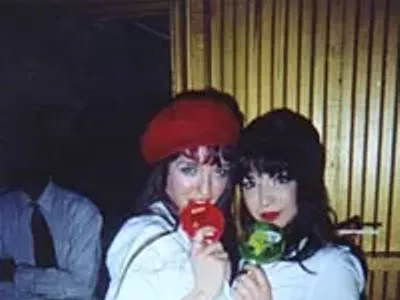
Audio By Carbonatix
[
{
"name": "GPT - Leaderboard - Inline - Content",
"component": "35519556",
"insertPoint": "5th",
"startingPoint": "3",
"requiredCountToDisplay": "3",
"maxInsertions": 100,
"adList": [
{
"adPreset": "LeaderboardInline"
}
]
}
]
“Don’t forget a painter’s got to kick the world in the ass, and if he’s real he won’t even know he’s doing it. He’s got what it takes, that’s all.” So said Jackson Pollock, regarded by many to be the most important artist of the 20th century.
The man we love to admire and condemn, to exploit and pity, Pollock came up through the art-world ranks in the 1930s. Then art became the hot new commodity in the late ‘40s and ‘50s, with Pollock leading the way with his “new drip technique.” He was soon elevated from oddity to abstract expressionist superstar. His ego savored the attention, but soon afterward the media hype devoured him — he felt he had given his soul away. He died in a car accident in 1956 at 44.
When we think of Pollock’s public persona, numerous words emerge: drunk, crazy, silent, violent. But does the Pollock mythos really live up to the man or is there more? Pollock is once again scrutinized, coveted and honored in a new anthology edited by Helen A. Harrison called Such Desperate Joy: Imagining Jackson Pollock (Thunder’s Mouth Press, $17.95, 409 pp.).
Attempting to cross the boundaries of the legend and give us snippets of the man, this anthology offers a diverse collection of writings — ranging from essays by art critics, interviews, recollections by artists, friends and neighbors, and personal letters to more obscure entries such as comic strips, poems and scripts inspired by Pollock. The volume arrives in time to give us a closer look at J.P. just before Ed Harris’ film, Pollock, arrives at the Detroit Film Theatre this weekend.
The film provides the primary characters in this painterly plot: Val Kilmer as Jackson’s friendly rival Willem de Kooning, Amy Madigan as financial backer Peggy Guggenheim and Jeffrey Tambor as art critic and J.P. cheerleader Clement Greenberg — and, of course, Harris as the man himself.
Harris, writing the forward for Harrison’s book, says, “Pollock’s desire to arrive at his own originality, the need, the courage to open himself up and surrender to that openness — and his unrestrained commitment to take it to its limit — drew me to him.”
Harris knew that portraying Pollock in the act of painting would be a crucial part of the film. So in the early ’90s, he learned to paint and built a studio where he could explore himself as a painter.
He writes, “It’s preposterous to think I could ever paint as he did, and yet I had to paint in the film. The most challenging part of all was gaining enough confidence to paint as myself, for myself, but in his manner — to be committed first to myself as a painter, keeping my focus on creating my own art, not creating someone else’s.”
The book is divided into sections, the first of which, “The Life and the Death,” begins with letters Pollock wrote to his father and brother Charles, signing them “Affectionately, Jacks.” Here we see a man just starting out as an artist — full of sensitivity and longing.
Among his relationships, the strong bond between Pollock and wife Lee Krasner was both nurturing and tumultuous. Krasner was also a struggling painter, and found it difficult to watch her husband’s growing success while her work was ignored. Jeffrey Potter offers fragments of statements by Pollock, where he’s noted as saying, “She’s talented, plenty, but great art needs a pecker. Not even Lee’s got that.”
Marcia Gay Harden, who plays Kraser in the film, says of her, “When she was first married, Lee’s main concern was pleasing Jackson. She was the kind of woman who hung her hat on another man’s peg to find herself, in spite of how brilliant she was in her own right.”
In the next section entitled “The Art,” we hear from artists and critics alike, such as artist George Segal. “I never met Pollock. They told me he was violent, deep, inarticulate, he drank too much, was passionate, revolutionary, put himself in his paintings. I had an image of Marlon Brando’s brooding pouting profile looking down while Stella ripped his teeshirt ... But Pollock’s creased forehead in his photographs intrigued me. He had the agonized look of a man wrestling with himself in a game of unnamable but very high stakes.”
Will Blythe spins a biting essay titled “The End of the Affair” in the third section, “The Man,” about Pollock’s mistress and art-world vamp Ruth Kligman, who was severely injured in the car wreck that killed Pollock. He writes, “Kligman pumped the bellows to inflame Pollock’s ego with hot gusts of adoration, trying to fill his psychic hollows with the kind of praise she one day hoped to merit, as either a genius ... or the soul mate of one.”
The book resolves itself in “Creative Responses,” where artists put their thanks for Jackson into the form of poems and plays and even music. The romantic in us will forever see Pollock, the “Action Painter,” dancing around one of his canvases in his blue jeans, a cigarette tucked in his mouth, hurling paint. The end of an exquisite piece of poetry by Patti Smith sums up the man for us:
Where blood and motion so infused
As a painter’s righteous blues
Polarized as God’s refuse
Silence rant by soles of shoes





